|
USS CONSTELLATION (1797)
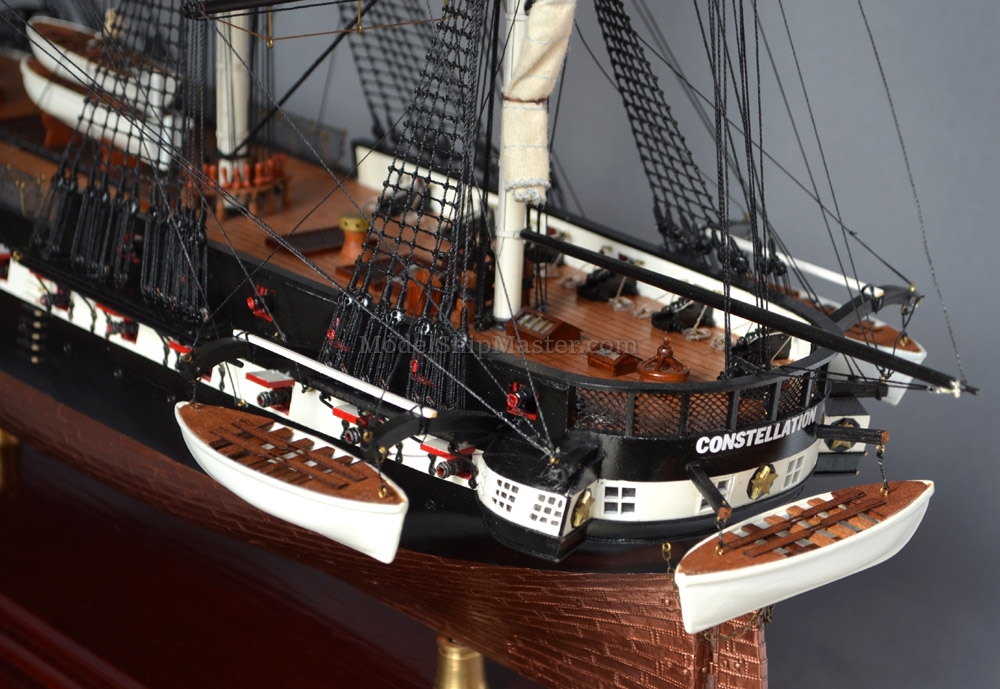
USS Constellation was a
38-gun frigate, one of the "Six Original Frigates"
authorized for construction by the Naval Act of 1794.
She was distinguished as the first
U.S. Navy vessel to put to sea and the first U.S. Navy
vessel to engage and defeat an enemy vessel.
Constructed in 1797, she was modified several times in
succeeding decades, and finally rebuilt beginning in
1853 as the sloop-of-war USS Constellation (1854).
After realizing that the
USS United States' failure, Joshua Humphreys' design was
long on keel and narrow of beam (width) to allow the
mounting of very heavy guns. The design
incorporated a diagonal scantling (rib) scheme to limit
hogging and included extremely heavy planking.
This gave the hull greater strength than conventional
frigates. Humphreys developed his design after realizing
that the fledgling United States could not match for
size the navies of the European states. He
therefore designed his frigates to be able to overpower
other frigates, but with the speed to escape from a
"ship of the line" (equivalent to a modern-day
"battleship").
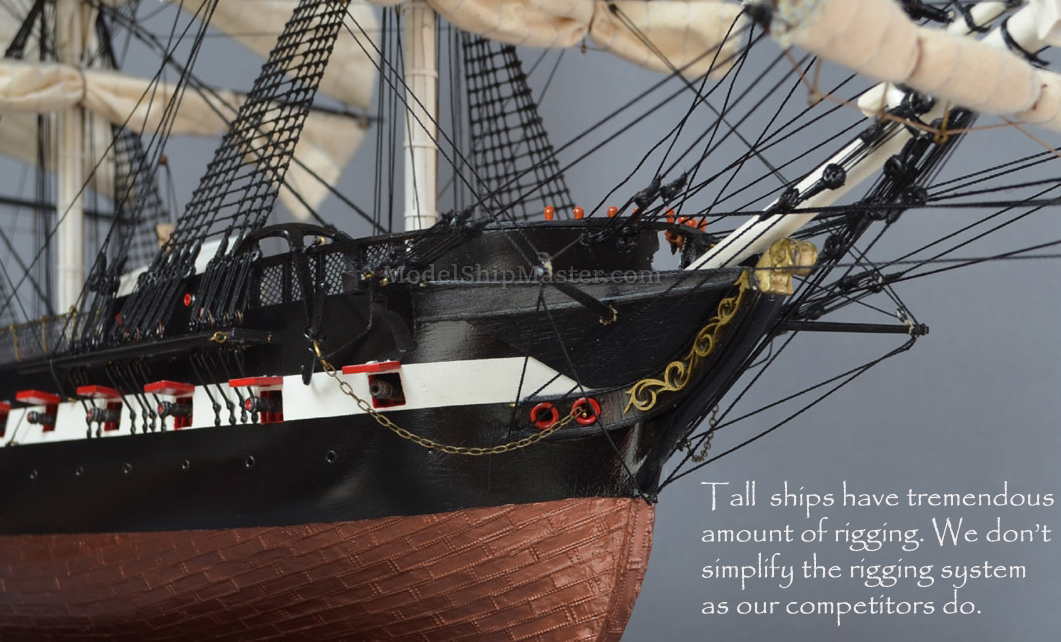
Constellation vs.
L'Insurgente:
On 9 February 1799, under the command of Captain Thomas
Truxtun, the USS Constellation fought and captured the frigate L'Insurgente of 36 guns, the fastest ship in the French
Navy. L'Insurgente had recently captured Retaliation, a
schooner, in November 1798 and three weeks previous had
been chased by the USS Constitution and had escaped.
L’Insurgente's job was that of commerce raiding; she
wanted nothing to do with another warship and tried to
flee Constellation. Within an hour of hauling in
chase Truxtun was close enough to make private signals
to identify if the ship he was pursuing was British or
not. With no answer, he proceeded to chase
L'Insurgente down, clearing for action and beating to
quarters. USS Constellation crowded on all sail
despite a rising squall that threatened to tear a sail
or throw a spar.
Reefing sail just long enough to weather the short
squall, USS Constellation hardly paused but the same was not
to be for L'Insurgente as her topmast snapped and slowed
her to the onrushing Constellation. Captain Barreaut ordered L'Insurgente
to lay up and prepared to fight. L'Insurgente raised the French Tricolor and
Captain Barreaut tried to ask for parley. Captain
Truxtun refused to answer as his orders were to attack
any French warship or privateer. American
warships of this period fired for the hull as did the
British and each of the 24 pounders had been double shotted. L'Insurgente fired at the Constellation's masts
and rigging. Constellation's masts were saved when
her sail was reduced taking pressure off the damaged
mast. L'Insurgente was devastated by
Constellation's first broadside. L'Insurgente tried to
board but this allowed Constellation to shoot ahead and
crossed her bows for a bow rake with another broadside.
USS
Constellation crossed to windward and L'Insurgente
turned to follow with both crews now exchanging port
broadsides instead of starboard. One of
Constellation's 24 pounders smashed through the hull of
L'Insurgente. L'Insurgente's 12 pounders were not
equal to the same task against Constellation's hull.
Captain Barreaut had been shown one of Constellation's
24 pound cannonballs and understood that he was in a
completely unequal contest with sails down and nothing
comparable to reply with many already dead and wounded.
He struck colors— thus comes the first major victory by
an American-designed and -built warship.
USS Constellation vs.
La Vengeance:
During the night on February 1st, USS Constellation
encountered the French much more powerful
frigate La Vengeance that had 52 guns. La
Vengeance attempted to run and had to be chased
down. An hour after sunset Constellation
came into hailing range and when La Vengeance
was ordered to stand to and surrender, she
answered with a broadside. After an hour
Constellation's foresails failed and had to be
repaired; she then overtook La Vengeance and a
running battle exchanging broadsides continued.
Twice the ships came close enough that boarders
were called for on both ships, the second
occasion was quite bloody as US Marines in the
Constellation shot up the deck of La Vengeance
leaving her deck covered in bodies of the dead
and wounded. After a five-hour battle,
although Vengeance twice struck her colors and
was close to sinking, she was able slip into the
darkness to escape from USS Constellation which,
disabled by the loss of her mainmast, proved
unable to pursue. La Vengeance was so holed in
the hull and her rigging so cut up that she
grounded outside the port of Curaçao rather than
attempt to sail into port for fear of sinking. The French commander was so humiliated he later
boasted that the American ship he had fought was
a much larger and more powerful ship of the line
(The US never had a ship of the line!)
After the encounter, the Constellation's speed
and power inspired the French to nickname her
the "Yankee Racehorse."
USS Constellation
also served in the two Barbary wars and the 1982
war with Great Britain.
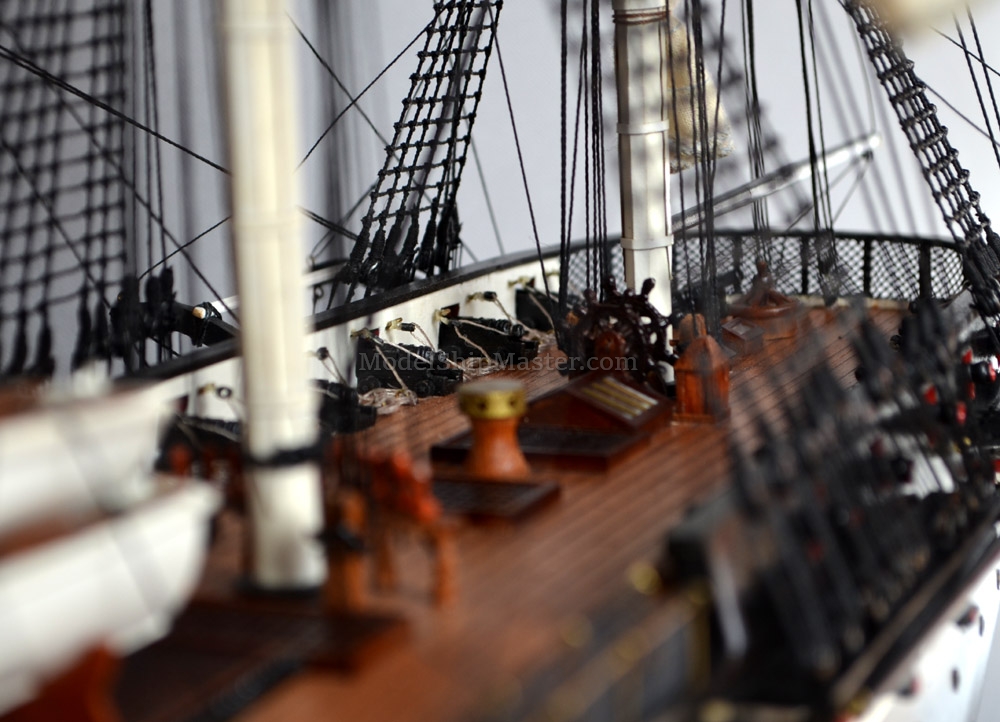
In 1853, USS Constellation was
struck and broken up for scrap at the Gosport Navy Yard
in Portsmouth Virginia. At the same time, the keel was
laid for what became known as the sloop of war USS
Constellation (1854). By the 20th century, the 1854
version was widely believed (including by the U.S. Navy)
to be the 1797 version. In the latter half of the
20th century, the city of Baltimore continued to promote
the ship as the original, but some naval historians
understood the ship to be an 1854 sloop-of-war rebuild
of the original frigate, using a number of original
parts. Commemorative copper coins were struck from
parts of the USS Constellation, and have become
collector's items.
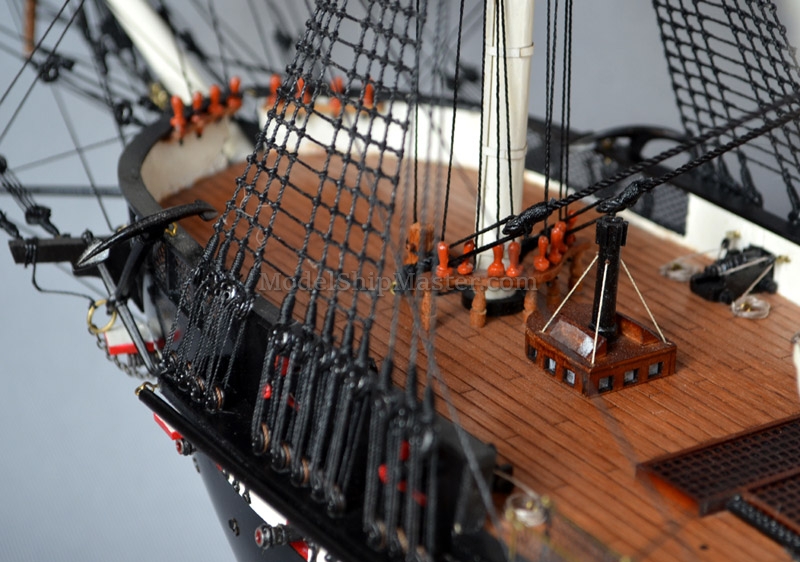
About the construction of the
USS Constellation model:
- Built from scratch over
hundreds of hours by master artisans
- The boats are real wood, with real
planks. We are the only one who stays true to the art of
tall ships
- Plank-on-frame construction.
-
Copper-plated bottom:
individual copper pieces (no fake lines.)
-
Blackened metal cannons and wooden carriage.
Under the main deck, all guns are "real" guns which
have proper barrels and wooden carriages which sit on 2
real decks under the main deck. These
guns are not simple barrels inserted into a solid hull
like in a cheap model.
- Authentic extensive rigging system comprised of many
different sizes of rope and features numerous blocks and
deadeyes
Dimensions and price of
the USS Constellation
model:
36" long x
27" tall x 13" wide
27" long x
27" tall x 13" wide
Contact us for prices. This USS
Constellation model
is built per commission only. We require only a
small deposit to start the process.
Click on this link for
lead time.
Add light feature to delight your guests in a dimly lit
room: $300. Powered by a
standard 9v battery under the base, with on/off switch.
This option is only
available on the larger model.
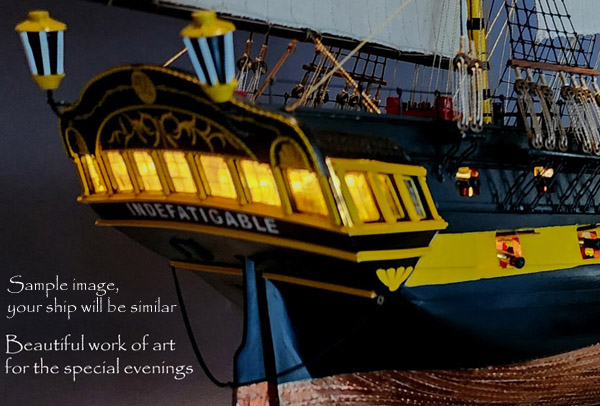
Click here to learn more
about the tall ship USS Constellation:
https://en.wikipedia.org/wiki/USS_Constellation_(1797)
|